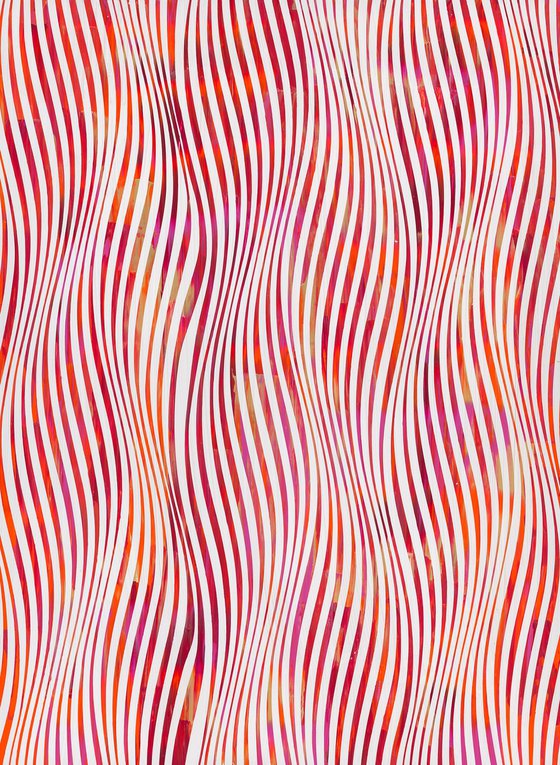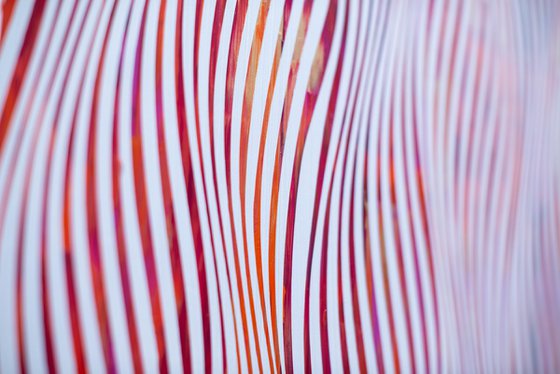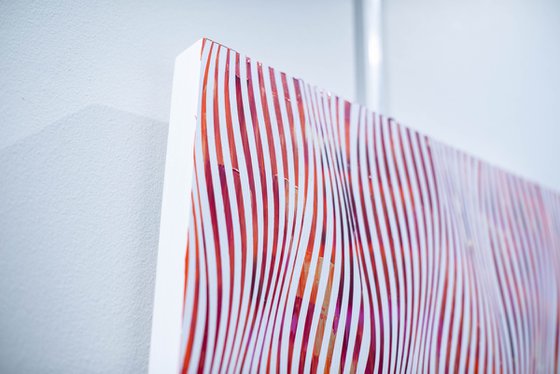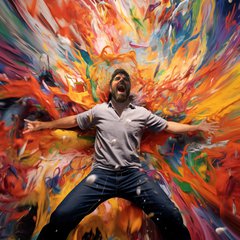- By medium
- By subject
- By budget
- Sales
- Gift cards
- Discover all art
- Artists
- Editors’ picks
- Ideas
Original artwork description:
“Chromatic Hallucinations” is a body of work that focuses on the ideals of pattern. It can represent many different things throughout humanity. The people, the beliefs they follow, the natural world around you, the history of subjects and the traditions that have been followed. Different colors and shapes vary meanings throughout different cultures, but the idea is carried down from generation to generation. From birth to death, pattern is a part of everyday life and cultural practice. The drive to recognize and form patterns can be from a glimpse into curiosity, discovery of new ideas and experimentation through everyday life. Da Vinci found this “Way of Stimulating and Arousing the Mind to Various Inventions” so invaluable that he applied it not only visually, as a means of inventing landscape or battle scenes, but in musical matters as well. The more patterns we can recognize, the wider our imaginative and creative scope. There is a revolution in the science of design under way, and most people, including designers, aren’t even aware it is taking place. Color, for example, was just researched to find that simply glancing at shades of green can boost creativity and motivation. It is easy to assume that there is correlation between verdant colors and vegetation capable of bearing food, which would mentally trigger the thought of nourishment. There is a science between window views of landscapes aiding in patient recovery, learning in classrooms and expanding productivity in the workplace. Additionally, certain patterns also have a universal appeal. Humanity responds dramatically to balanced pattern so much so that it has been researched to reduce stress levels by as much as 60 percent, just by being the field of vision of the viewer. In a recent piece for Medium, Kevin Ashton recently analyzed “how experts think.” Stating, “It turns out patterns matter, and they matter a lot. A star football quarterback needs to recognize all kinds of patterns – from the type of defense he’s facing, to the patterns his receivers are running, to the typical reactions of defenders. These, of course, has to happen in a matter of nanoseconds, as a 300-pound lineman is bearing down on you, intent on ripping you limb from limb.” The more you are thinking about pattern, the more you can see patterns all around you. Get to work on time in the morning is the result of recognizing patterns in your daily commute and responding to changes in schedule and traffic. Diagnosing an illness is the result of recognizing patterns in human behavior. The same goes for just about any field of expert endeavor – it’s just a matter of recognizing the right patterns faster than anyone else. The future of intelligence is in making our patterns better, our heuristics stronger. In Kevin Ashton’s previously mentioned article, he refers to this as “Selective Attention” which is about focusing on what really matters so that poor selections are removed before they ever hit the conscious brain. While some may be skeptical of Kurzweil’s Pattern Recognition Theory of Mind, they also tend to admit that Kurzweil is a genius. One thing is clear, and that is being able to recognize patterns is much what gave humans their evolutionary edge over animals.
Materials used:
Acrylic on Wood Panel
Tags:
#contemporary #blue #bold #vivid #vibrant #cool #psychedelia #psychedelic #optical art #op art #optical illusionThe One Who Stuck Out (2022)
Acrylic painting
by Sean Christopher Ward
6 Artist Reviews
£577.92
- Acrylic painting on Panel / Board / MDF
- One of a kind artwork
- Size: 45.72 x 60.96 x 5.08cm (unframed) / 45.72 x 60.96cm (actual image size)
- Ready to hang
- Signed on the back
- Style: Geometric
- Subject: Abstract and non-figurative
Original artwork description
“Chromatic Hallucinations” is a body of work that focuses on the ideals of pattern. It can represent many different things throughout humanity. The people, the beliefs they follow, the natural world around you, the history of subjects and the traditions that have been followed. Different colors and shapes vary meanings throughout different cultures, but the idea is carried down from generation to generation. From birth to death, pattern is a part of everyday life and cultural practice. The drive to recognize and form patterns can be from a glimpse into curiosity, discovery of new ideas and experimentation through everyday life. Da Vinci found this “Way of Stimulating and Arousing the Mind to Various Inventions” so invaluable that he applied it not only visually, as a means of inventing landscape or battle scenes, but in musical matters as well. The more patterns we can recognize, the wider our imaginative and creative scope. There is a revolution in the science of design under way, and most people, including designers, aren’t even aware it is taking place. Color, for example, was just researched to find that simply glancing at shades of green can boost creativity and motivation. It is easy to assume that there is correlation between verdant colors and vegetation capable of bearing food, which would mentally trigger the thought of nourishment. There is a science between window views of landscapes aiding in patient recovery, learning in classrooms and expanding productivity in the workplace. Additionally, certain patterns also have a universal appeal. Humanity responds dramatically to balanced pattern so much so that it has been researched to reduce stress levels by as much as 60 percent, just by being the field of vision of the viewer. In a recent piece for Medium, Kevin Ashton recently analyzed “how experts think.” Stating, “It turns out patterns matter, and they matter a lot. A star football quarterback needs to recognize all kinds of patterns – from the type of defense he’s facing, to the patterns his receivers are running, to the typical reactions of defenders. These, of course, has to happen in a matter of nanoseconds, as a 300-pound lineman is bearing down on you, intent on ripping you limb from limb.” The more you are thinking about pattern, the more you can see patterns all around you. Get to work on time in the morning is the result of recognizing patterns in your daily commute and responding to changes in schedule and traffic. Diagnosing an illness is the result of recognizing patterns in human behavior. The same goes for just about any field of expert endeavor – it’s just a matter of recognizing the right patterns faster than anyone else. The future of intelligence is in making our patterns better, our heuristics stronger. In Kevin Ashton’s previously mentioned article, he refers to this as “Selective Attention” which is about focusing on what really matters so that poor selections are removed before they ever hit the conscious brain. While some may be skeptical of Kurzweil’s Pattern Recognition Theory of Mind, they also tend to admit that Kurzweil is a genius. One thing is clear, and that is being able to recognize patterns is much what gave humans their evolutionary edge over animals.
Materials used:
Acrylic on Wood Panel
Tags:
#contemporary #blue #bold #vivid #vibrant #cool #psychedelia #psychedelic #optical art #op art #optical illusion14 day money back guaranteeLearn more





